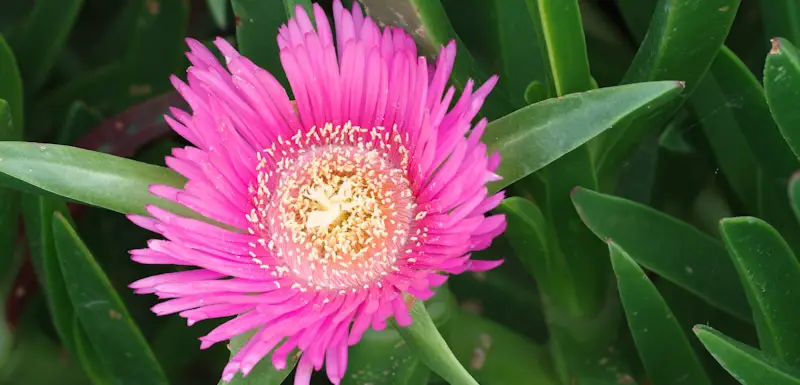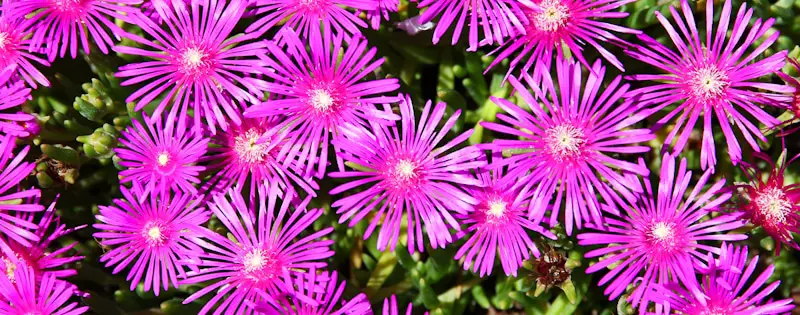Ice Plants are truly a sight to behold. Their breathtaking thin leaves reflect light in such a manner that they appear like ice crystals. Hence, the reason these sparkling flowers are known as the Ice Plants.
Many types of ice plants are known to nature, occurring in every possible color. These can be classified based on size, flower color, and leaf structure. Their foliage becomes vibrant in cold weather, turning into shades of red, orange, purple, and blue.
But what are the different types of ice plants? And which one will suit your lawn the best? If you are wondering the same questions, you have reached your destination.
In this article, we will discuss all the different varieties of Ice Plants to help you choose the best companion for your garden.

What Are Ice Plants?
Ice plants are a type of succulents usually found in coastal and arid environments. Gardeners often use them as groundcovers because of their low-lying nature and gorgeous vibrant flowers.
While most Ice Plants possess elongated, green leaves that resemble plump fingers, the foliage of others can lie anywhere along the color gradient, depending on their type.
Most of the species are from South Africa and, therefore, are suited to an environment with scant rainfall, intense winds, salt water, and barely any soil. So, don’t be surprised if you find these plants scattered over rocky bluffs on your nearby coast!
Ice Plants are often deemed as perfect ornamental plants because of their resilient nature. They are drought-tolerant and can survive all kinds of temperatures. Though, as mentioned above, they thrive best in coastal and arid conditions, but you can still grow them in any other climate as long as you provide satisfactory drainage of excess water.
There is a chance that you might have seen these beautiful plants without even realizing. Hottentot fits, or Carpobrotus edulis, is practically found everywhere around the United States, especially along the freeways of California. These are usually yellow in color with bright, succulent leaves; most Californians refer to them as Highway Ice Plants.
Types of Ice Plants
Now that we have covered the basics of Ice Plants, let’s get to their types and varieties. These are some of the popular, widely-planted types of Ice Plants.
Baby Sunrose/ Red Apple Heartleaf; Aptenia
Also known as Baby Sunrose and Red Apple Heartleaf, Aptenia is ideal for anyone looking for a low-maintenance ice plant. It looks beautiful as a groundcover or in a hanging basket. This variety is a tropical perennial that requires little to no care and can grow on its own. All you need to do is provide thirty minutes of direct sunlight and keep it in well-drained soil, and ta-da! You are all set to witness your garden becoming rosy, red, and gorgeous.
Even though Baby Sunrose does not need plenty of water to grow, you might need to provide it with proper watering and misting sessions to help it survive the growing season. And since Aptenia only requires about 2 degrees Fahrenheit temperature to develop, you can keep it in any place without any worry.
Highway Ice Plants; Carpobrotus edulis
One of the most often planted kinds, the highway ice plants, are grown in gardens and as an indoor potted plant. They are widespread in California, where they cover road embankments and help with erosion prevention.
One of the simplest propagation methods of these highway plants is by cutting the stem of an existing plant and rooting it in the new soil. The layers should be roughly 30 centimeters long, with a minimum of five centimeters of the plant above the soil or gravel. However, if you prefer something simpler, you can always go for the conventional “seed-sowing” method.
Since these highway plants need full sun exposure to grow, it is ideal to place them near a window with loads of direct sunlight. You can do this without fear since they can easily survive through high temperatures. But cold, frosty winds? Not so much.
In short, with requirements as simple as well-drained soil and regular watering, Highway Ice Plants are a perfect way to take the look of your gardens, backyard, or indoor space up a notch.
Red Spike Ice Plant; Cephalophyllum alstonii
Red Spike Ice Plants, as the name suggests, develop red leaves when the weather gets cold. They usually flower during the spring season and grow in tight clumps, ranging from three to five inches in height. The fibrous roots of these plants can act as ideal soil stabilizers for slopes and water banks.
If you plan on getting these plants, you need to provide them with good drainage and plant them in a location where people won’t step on them. Hence, rock gardens, borders, water banks, slopes, and other related sites are the most suitable setting for them.

Wheels Of Wonder Ice Plant; Delosperma
Want to decorate your garden with some bright, colorful flowers? If yes, you better get your hands on these fire wonder ice plants.
These mat-forming, vibrant succulents accentuate orange-red flowers with evergreen foliage to impart a grand look to your space.
They bloom in early summers till fall and can grow up to four to six inches tall, spreading over an area of 18-24 inches. Wheels of wonder require direct sunlight and well-drained soil to grow. But the secret to their optimum growth lies in their soil which should neither be too dry nor too wet. Dry soil can not support plants’ photosynthesis, while one with excess water can cause the plant to develop poorly and even die.
Overall, these ice plants are easy to grow and ideal for dry and sunny locations. You can plant them in your rock gardens, border fronts, slopes, and banks to furnish them with a beautiful look.
Dewflowers; Drosanthemum floribundum
Dewflowers get their name from their shiny translucent petals that give the flowers a wet-misty look. This particular species is active and can soon grow to form a stunning carpet of lilac purple flowers and succulent foliage on the ground.
These plants usually bloom from late spring till early summer, grow six inches tall, and spread several feet. Their flowers open up around midday when the sun is bright and close when it sets. However, the buds can remain closed throughout the day if the sky is covered with clouds and the weather is cold.
The growing requirements for Dewflowers include direct sunlight, moderate water, and dry yet well-drained soil. Therefore, they are ideal for people who are lazy or bad at caring for their plants. Dew Flowers are also excellent for rock gardens or as a ground cover.
Why Should You Get Ice Plants for Your Garden?
There are many reasons why ice plants can prove to be ideal for your garden.
1. Works with All Types Of Planting Arrangements
These succulent plants have a trailing growth habit and can be planted anywhere from small boulders and pots to retaining walls. Regardless of the location, they will spread vigorously to give your place a burst of color in no time.
2. Fire Resistant
Ice plants are fire resistant and can act as a shield for your home by stopping the embers from getting through.
3. Controls Soil Erosion
Ice plants are best for erosion control. They are usually planted on dry and sunny hillsides, where their roots anchor the soil and prevent it from flowing with the water.
Final Words
Ice Plants are as beautiful as they can get. From rock gardens and retaining walls to hanging pots, you can grow them in any arrangement without any issue. Most of them require moderate water quantity and can grow in any condition, hot or cold.
And, no matter the color, size, or style you prefer, Ice Plants probably have a species to cater to your needs. In a nutshell, these plants are ideal for anyone who is into gardening and is not afraid to try something new.
Victoria is the owner and main author of hobby plants. She loves spending her free time in her garden planting and taking care of her plants. Victoria hopes you enjoy the content here!
![The Types of Prayer Plants: [Varieties Explained] The Types of Prayer Plants: [Varieties Explained]](https://www.hobbyplants.com/wp-content/uploads/2022/09/types-of-prayer-plants-300x158.jpg)

![What Are Ground Cover Plants? [Varieties Explained] What Are Ground Cover Plants? [Varieties Explained]](https://www.hobbyplants.com/wp-content/uploads/2022/08/ground-cover-plants-300x158.jpg)
![What Are The Types Of Dracaena Plants [Answered] What Are The Types Of Dracaena Plants [Answered]](https://www.hobbyplants.com/wp-content/uploads/2022/07/types-of-dracaena-plants-300x158.jpg)
![How Big Do Different Types Of Azaleas Get? [Find Out Here] How Big Do Different Types Of Azaleas Get? [Find Out Here]](https://www.hobbyplants.com/wp-content/uploads/2022/09/how-big-do-azaleas-get-300x158.jpg)
![Bleeding Heart Plant Varieties [COMPLETE BEGINNER'S GUIDE] Bleeding Heart Plant Varieties [COMPLETE BEGINNER'S GUIDE]](https://www.hobbyplants.com/wp-content/uploads/2022/07/bleeding-heart-plant-300x158.jpg)
![Prayer Plant At Night: What Makes Them Unique? [EXPLAINED] Prayer Plant At Night: What Makes Them Unique? [EXPLAINED]](https://www.hobbyplants.com/wp-content/uploads/2022/07/prayer-plant-at-night-300x158.jpg)
![Why Are My Peace Lily Leaves Turning Brown? [EXPLAINED] Why Are My Peace Lily Leaves Turning Brown? [EXPLAINED]](https://www.hobbyplants.com/wp-content/uploads/2022/07/peace-lily-leaves-turning-brown-1-300x158.jpg)
![Why Does My Majesty Palm Have Brown Tips? [EXPLAINED] Why Does My Majesty Palm Have Brown Tips? [EXPLAINED]](https://www.hobbyplants.com/wp-content/uploads/2022/08/majesty-palm-brown-tips-300x158.jpg)
![Best Soil For A Money Tree? [DIFFERENCES EXPLAINED] Best Soil For A Money Tree? [DIFFERENCES EXPLAINED]](https://www.hobbyplants.com/wp-content/uploads/2022/08/best-soil-for-money-tree-300x158.jpg)
![What Causes Brown Tips on A Ponytail Palm? [EXPLAINED] What Causes Brown Tips on A Ponytail Palm? [EXPLAINED]](https://www.hobbyplants.com/wp-content/uploads/2022/08/brown-tips-on-ponytail-palm-300x158.jpg)
